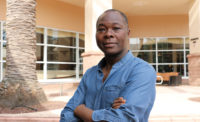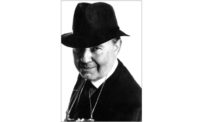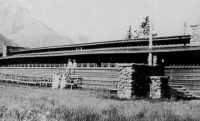When British design journalist Frances Anderton first visited Los Angeles in 1987 as a cub reporter for the Architectural Review, she found herself smack in the middle of the city’s vibrant design scene. Her first assignments, part of a special issue on L.A., had her rubbing elbows with Frank Gehry and Thom Mayne and scouting wild new buildings like an Eric Owen Moss–designed warehouse and a KFC franchise shaped like a gigantic chicken bucket. Anderton relocated to the city permanently in 1991 and became an editor at LA Architect, and later a producer for the influential radio programs Which Way, L.A.? and To the Point for local NPR affiliate KCRW.
Architects, however, are most likely to know Anderton for her beloved program DnA: Design and Architecture, which has made her something of design’s Terry Gross. Since 2002, Anderton has chronicled the dramas that continue to shape the City of Angels, from the never-ending LACMA redesign saga to the transformation of the L.A. River, through the voices of guests ranging from Zaha Hadid to Ben Stiller. In September, the Los Angeles Times broke the news that 24 KCRW employees, including Anderton, would be taking buyouts due to the financial strain of Covid-19. The Twitter reaction was swift (“No it can’t be true?!?!!!” lamented Barbara Bestor), though Anderton is quick to remind you that she’ll be at the station through December 15. RECORD caught up with the journalist at home in Santa Monica to reflect on her time as DnA’s host.
Describing architecture in print is hard enough. What are the challenges of describing buildings over the airwaves?
Well, it is the primary challenge. And what you find is, you spend less time on the details of the building—you try and condense that down to brushstrokes. You’re looking for personalities, stories, conflict—you’re looking for stuff that emotes.
Does a particular experience stand out?
I did meet Elon Musk and sit in the Tesla Model S before it hit the market.
What about architects? Were you surprised by any of their personalities?
What singles out the majority of architects who get ahead is, they’re very cogent speakers. Just to pick: Frank Gehry. Whatever impressions people might have of his work, the bottom line is, he’s extremely clear about what he’s doing. So is Bjarke Ingels, and Barbara Bestor too.
Any architects who have turned out to be, perhaps, unpleasant?
Do you think I’m going to say that? [Laughing.] Well, I can tell you that the L.A. Times asked me to interview Rem Koolhaas, and he proved to be the most difficult person to chase down and interview, to the point of being extremely rude. I think architects are better behaved with the press than they might be with some other people. I think, generally, I see the good face of architects. And, generally, I genuinely get on with them.
What are the persistent issues you’ve seen play out in L.A.’s built environment?
When I moved here, homeless people were concentrated largely in Downtown L.A.’s Skid Row. Now we have the unhoused across the city—it’s a massive, huge problem. There’s a lot of talk about how we need to build more housing, but that’s incredibly difficult, because homeowner associations and their elected officials will fight tooth and nail to stop multifamily housing from going into single-family neighborhoods. My hope is that [because of the pandemic] multifamily housing will be better, that it will figure out a way to offer people the healthful aspects of the L.A. lifestyle while maintaining the density.
So, what’s next for you? Was it hard to leave the station you’ve called home for the last two decades?
I’ve been at KCRW for 22 years; it has been my home as much as L.A. is my home. The station had a very particular character when I joined it, which has changed over time as a new generation brings in its values, desires, and ways of storytelling. Two decades ago, we got the car-driving audience. Now there’s a proliferation of sources for audio storytelling, so a buyout made sense for me. But that doesn’t mean it wasn’t painful. When the news broke, I was astonished at how many people expressed concern that the station wouldn’t be covering design and architecture anymore. I will say I’m having conversations about how to keep that discussion alive. I did joke in a tweet about how I was going to either keep on talking about design or go start a goat farm.
Can we rest assured that whatever you do will be in L.A. and will be about design?
Well, yes, at least for the foreseeable future. People’s interest has actually reinforced my sense that the conversation hasn’t finished yet.







Post a comment to this article
Report Abusive Comment